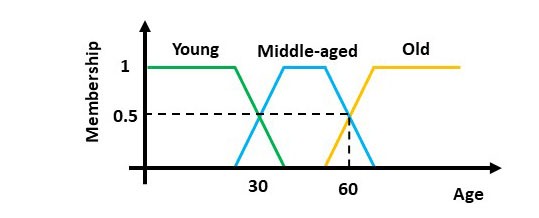Hamid Ebrahimi is a PhD candidate in Mechanical Engineering. Hamid obtained his bachelor’s degree from Ferdowsi University of Mashhad, and completed his master’s degree at K.N. Toosi University of Technology. Hamid co-developed a novel laser-based bioprinter during his PhD, which could potentially be used to print organs for organ transplantation. Hamid has over five years of teaching and R&D experience in dynamic system modeling, optics, computational fluid dynamics, bioinformatics and tissue engineering.
Blog post
Fuzzy logic: A strategy that can quantify the way humans think
 Credit: pinterest.ca
Credit: pinterest.ca
Probably, we all agree that we should not see the world in black and white. One of our most important abilities as human beings, which separates us from machines, is the ability to see events as something between black and white poles; which is called “grey thinking”.
In our daily lives, we are definitely faced with situations where we have to use grey thinking to get better results. For understanding this concept, let me ask you a few random questions:
- Ever wonder how and to what extent you press the brake pedal when an obstacle appears in your way while driving?
- Or have you thought about how you bring the heat of the water to your desired temperature for showering?
- Or have you thought about your friend's level of honesty?
- Or basically how do you consider a person as your best friend?
 Fuzzy logic point of view on distance between two cars, (Edited; clipartkey.com & imgur.com)
Fuzzy logic point of view on distance between two cars, (Edited; clipartkey.com & imgur.com)
The answers to the questions are probably something like the followings:
“If the obstacles were a bit close, I would slowly press the pedal”; or “if it was too cold, I would quickly open the hot water tap”; or “my friend would not be honest sometimes”; or “a close friend is someone I have true intimacy with.”
Paying attention to the adverbs indicates two important points. First, most of the adverbs are somewhat between the two black and white poles (grey). Second, in all cases, our answers were qualitative.
If there is a way that can quantify these qualitative concepts and make them intelligible to machines, we will certainly see in the future that machines behave like humans!
Years ago, Dr. Zadeh introduced a method that can quantify qualitative concepts without losing useful information from grey thinking, known as "fuzzy logic."
In this method, firstly all the qualitative states of an event are assigned a probability function called the membership function. For example, to separate young, middle-aged and old age groups, membership functions can be as shown below:
 Fuzzy logic membership function on age groups
Fuzzy logic membership function on age groups
Next, the decision to be made for each membership function must be described in conditional terms. For example, let's say we want to adjust working hours based on the age group. Conditional expressions will be:
“If you are old, you have to work zero hours”
“If you are middle-aged, you have to work 35 hours”
“And if you are young, you have to work 40 hours.”
With these conditional expressions, we can now use our own fuzzy network. Suppose I am 60 years old, as you can see in the membership functions, I belong to the old group 50% and the middle-aged 50%. The decision that will be made for my working hours will definitely be something between 0 and 40 hours. There are mathematical methods for accurately determining this number using membership percentage. For example: Mamdani and Sugeno systems.
This was a simple example; in most cases, the determinants and their interdependencies will be very complex, and the performance of fuzzy logic will be clearly seen in those examples.
Fuzzy logic vs. probability and crisp logic
One of the points that must be considered in understanding fuzzy logic is the difference between this logic, probabilities and crisp logic.
Fuzzy logic takes the essential concepts of vagueness, while in probabilities, we are looking for events that may or may not happen. Another point is that fuzzy logic considers the truth degrees in modelling, while the mathematical model of probabilities is based on ignorance. Finally, fuzzy logic evaluates an event after it has occurred, while probability theory evaluates an event before it occurs. On the other hand, crisp logic defines a strict boundary between the different poles of an event.
With this explanation, let’s go back to the above-mentioned example and see how fuzzy logic, probability and crisp logic interpret my age group.
- Fuzzy point of view: My degree of membership within the set of old group is 50%
- Probability point of view: There is a 50% chance that I am old.
- Crisp point of view: I am 60 years old
Fuzzy logic applications
After the introduction of fuzzy logic, one of the first attempts to apply this method was certainly in engineering-related fields. First, this method was used in devices that needed to be controlled by humans to achieve better performance. Examples include:
- in the aerospace industry for altitude control of aircraft and satellites,
- in the automotive industry for the traffic control, automatic transmission, speed control
- in autopilot mechanism of planes, ships, and under-water vehicles
- in the advancement of the washing machine, vacuum cleaner and microwave ovens
- in a wastewater treatment plant to control the aeration for the treatment
But today, this logic has applications beyond the engineering fields, and it's because of its amazing decision-making power, such as:
- in the decision-making process in businesses, employees, and workers evaluation
- in modelling for NATO decision making
- in stock market predictions
- In government service agencies
- In quality control services
- In monitoring and controlling of the Anaesthesia
- In diagnosing the diseases; and so on
Looking at how fuzzy logic works, we have certainly realized that this method can greatly improve the decision-making power of machines and algorithms. And eventually, it will cause machines to adapt to human life, not to change our lives into machine lives!!
About the author
